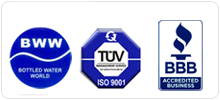Desalination Points to Ponder
Water is a source of life but the world has a total of 1.65 billion km3 of Water. However, only 0.3% of this total quantity is theoretically usable as a fresh water, and only 10% of that i.e. 0.03% of the world's water is capable of economical utilization.
In the environment report Global 2000 the following comments occur: The notion that water is a freely available resource will no longer be encountered anywhere in the world in 20 years time Worldwide sea water desalination has been a very effective and economical way of producing potable water for drinking and industries. It is a myth that, sea water desalination is exorbitantly expensive.
But the fact that it is affordable. Reverse Osmosis plants to convert sea water to potable drinking water and for other usages have been prevalent throughout the world for more than 3 decades. The sea water Reverse Osmosis membranes have improved in technology and efficiency over the last 15 years. The current technology available for seawater Desalination through Reverse Osmosis System has proven to be cost effective and easily maintainable. With proper process design and efficient conservation of energy sea water Desalination system with Reverse Osmosis can be a long-term solution at an affordable price.
With technologies to save power such as energy recovery turbines cost per ltr of Desalinated sea water to potable water can work as low as US$0.001 per litre, including cost of running, maintenance and power. Efficiency Expertise Canadian Clear Group of Companies was established in 1972 to overcome the need for pure potable water for drinking and for industries. In Canadian Clear our Research and Development wing have worked to design, develop, manufacture complete Water Treatment and Purification System. For the last four decades Canadian Clear has successfully designed, manufactured, installed and commissioned a number of Water Treatment Plants with Indigenous and foreign technical know-how to prime industries, fertilizers, hospitals, Government and semi-Government organization, off-shore oil rigs, refineries, soft drink manufacturers, breweries and mineral water manufacturers for various applications.
With proper selection of sea water source understanding the factors of high tide and low tide, backwaters of sea can be exploited with much higher efficiency through the Reverse Osmosis System than directly drawing water from the sea. The sea is an endless resource of water and will never deplete even if large quantities of water are drawn from its resource.
The reject water from the Reverse Osmosis System can be sent back in the sea as they constitute only with concentrated salts which was originally available in the sea water. The concentrated salt is of such micro-level that it can never increase the concentration of salts in the sea water. Alternatively, the reject water from the Reverse Osmosis System can be utilized for producing common salt by natural drying method or by flash evaporators or other salt recovery methods. The investments on Desalination Plants today are not highly exorbitant as it was 15 to 20 years ago. With world market opening up to open trade the viabilities of such projects are very encouraging.






























 Toll Free
Toll Free
